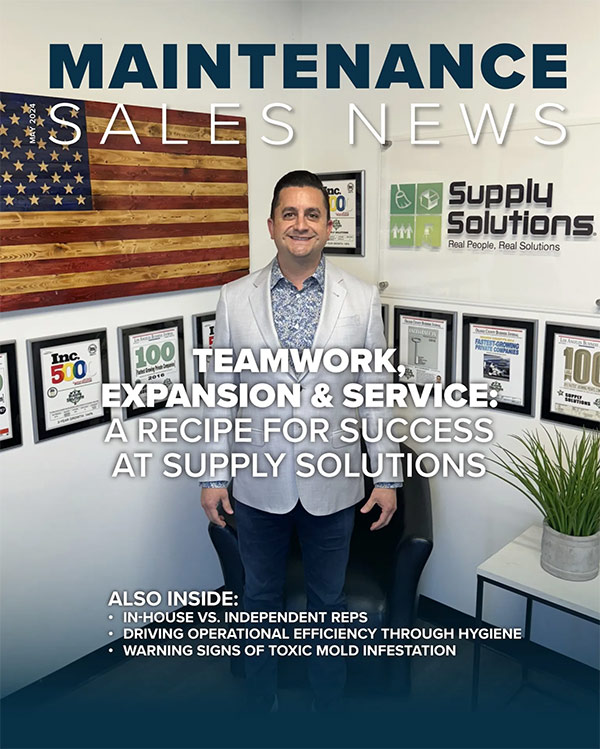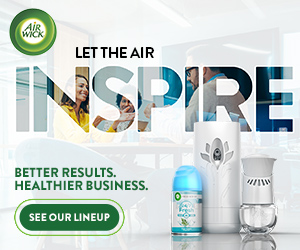6 Strategies To Prevent And Resolve Mold For The Maintenance Industry
By Laura Champagne, Owner of Natural Home Solutions
Climate change has caused more hurricanes, tropical storms, and torrential rainfall across the country this year, putting more business complexes, warehouse buildings and commercial properties at risk of leaking and flooding. Water-saturated structures are prime breeding grounds for mold, but there are ways to prevent, detect, and remove it before it becomes a serious and costly issue with debilitating health effects.
Mold needs three things to grow: water, food, and humidity. Water will stealthily move into small porous surfaces of any building material, like drywall, plaster, wood, concrete, even fabrics, which then serve as a food source to quickly produce more fungus. Common sources of undetected water flow include foundation problems, poorly installed windows, roof concerns, storm damage, leaky pipes, HVAC issues, faulty appliances, bathroom vent issues, and wet building materials. Mold also loves humidity and thrives in dark, warm environments, such as basements, lofts, building corners and bathrooms.
Once fully developed, microscopic mold spores break off a surface and travel throughout the air undetected by the human eye. Many property owners do not even realize that they have a mold infestation until it begins to cause compromised health symptoms among building inhabitants. Symptoms can present as headaches, chest tightness, wheezing, sneezing, coughing, difficulty breathing, fever, nose bleeds, and skin irritations.
It is therefore imperative for maintenance managers to recognize the warning signs of a toxic mold infestation and implement a viable solution for the safety and health of their peers, tenants, and customers, as well as avoiding costly abatement processes and potential legal action. Many insurance companies exclude mold-related issues in their policies, thus, the financial burden will fall on the responsible parties.
So, what are the warning signs that your facility has a mold problem? Obvious indicators are musty smells, black spots or water stains on walls, ceilings and floors, and warped building materials. A thriving mold colony can also rot wood flooring, destroy drywall, generate cosmetic and structural damage, and ruin interior furnishings.
It is important to note that sometimes an innocuous problem like a leaky faucet, overuse of water while cleaning or a window that doesn’t close properly, can cause a mold infestation. Even in new construction, water will find a way into unexpected places. Many historic buildings, which have been unoccupied or abandoned for a significant period of time, are now being repurposed into modern-day retail, restaurant and residential facilities. This trend is an important part of civic revitalization, economic growth, and historic preservation; however, the maintenance, humidity and water levels of these edifices are often unknown, which can be a prime location for mold growth.
The most reliable way to detect a mold outbreak is through an air quality and surface strip test, conducted by a professional mold remediation company and analyzed at a third-party laboratory. This independent lab then generates a report with the exact levels and species of mold present. When testing a food service company, this report is crucial in fulfilling mandated government and health department standards and certifications.
Once a mold contamination is detected, avoid solutions that may cause more damage. Frequently, janitorial directors use harmful chemicals to clean up the visible mold colonies. The issue with this approach is that the chemicals stop at the surface and evaporate away. Traditional mold removal may also incorporate a destructive strategy that requires tear-down, removal, and replacement of contaminated surfaces. This type of drastic action is often labor-intensive, extremely costly, and can cause more spore proliferation as the moldy materials are moved around. It also does not address the underlying problem in that if the area becomes wet again, the mold will reappear because it has been secretly living unseen within the wood studs.

A seemingly innocent window crack can develop into a mold infestation. (Photo courtesy of Natural Home Solutions)
Since mold is an organism found in the environment, the most effective way to fight it is with natural, organic enzymes. A green formula acts as a catalyst, breaking down the fungi, eliminating contamination, and preventing the release of spores. Additionally, they do not evaporate and continue working to prevent subsequent mold growth long after the treatment.
Enzyme-based solutions are often applied using a fogger to easily penetrate surfaces, small and difficult-to-reach areas, and duct work so that only clean, purified air is circulated around a building. They are safe for humans and pets and the enzymes only destroy mold without damaging furniture, furnishings, or property.
To prevent future mold outbreaks, facility operators may consider following six important strategies:
- Routinely inspect the outside of the property for foundation problems, poorly installed windows, clogged gutters, roof concerns, poor drainage, and storm damage to avoid water flow.
- Keep indoor humidity levels between 30 and 50 percent. Use a portable dehumidifier and an oscillating fan in the opposite corner of an area that is consistently above 60 percent humidity and consider an HVAC-compatible, whole building dehumidifier.
- Install bathroom fans and attic vents to remove moisture.
- Use mold-resistant building materials, such as wallboard, paint primer and porcelain, while avoiding carpeting as rugs with a high pile are prone to collecting mold and mildew.
- Regularly run dehumidifiers and air scrubbers: dehumidifiers remove the humidity, while air scrubbers eliminate the mold spores from the air.
- Conduct quarterly mold testing with a professional company to prevent serious problems and avoid costly property repairs.
In conclusion, mold spores grow rapidly and uncontrollably when they have enough water, warmth, and porous surfaces on which to feed and can cause serious harm to a building and its occupants. A maintenance manager needs to constantly monitor and mitigate mold problems with immediate evaluation and testing. When property owners fail to fix mold problems in a timely manner, they can become legally responsible for mold-related illnesses or property damage. When in doubt, seek the help of a professional mold removal company, which will prove due diligence and establish a timeline of resolution. If litigation is pursued, professional testing serves as documented evidence and its management can provide expert testimony to help structure a defense.
Bottom line when it comes to mold in a commercial or industrial business — an ounce of prevention is worth a pound of cure!
Laura Champagne is co-owner of Natural Home Solutions, a mold removal company committed to keeping homes and businesses safe from mold contamination through Xspor’s proprietary, organic EnzyCleanseTM solution. For more information, visit www.naturalhome.solutions.





